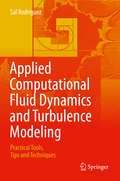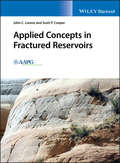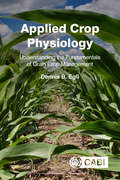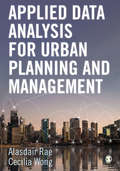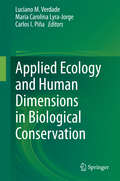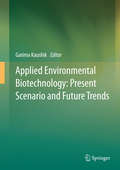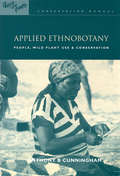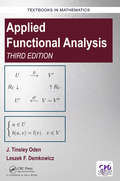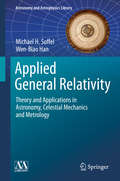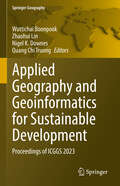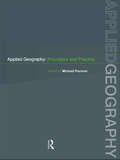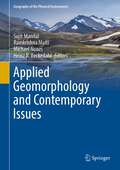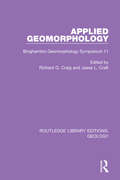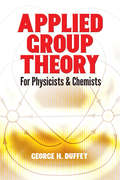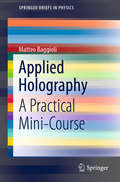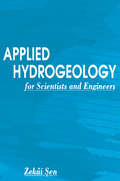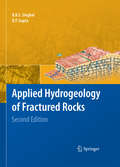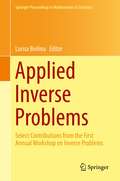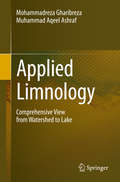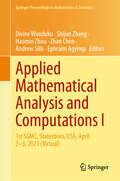- Table View
- List View
Applied Computational Fluid Dynamics and Turbulence Modeling: Practical Tools, Tips and Techniques
by Sal RodriguezThis unique text provides engineering students and practicing professionals with a comprehensive set of practical, hands-on guidelines and dozens of step-by-step examples for performing state-of-the-art, reliable computational fluid dynamics (CFD) and turbulence modeling. Key CFD and turbulence programs are included as well. The text first reviews basic CFD theory, and then details advanced applied theories for estimating turbulence, including new algorithms created by the author. The book gives practical advice on selecting appropriate turbulence models and presents best CFD practices for modeling and generating reliable simulations. The author gathered and developed the book’s hundreds of tips, tricks, and examples over three decades of research and development at three national laboratories and at the University of New Mexico—many in print for the first time in this book. The book also places a strong emphasis on recent CFD and turbulence advancements found in the literature over the past five to 10 years. Readers can apply the author’s advice and insights whether using commercial or national laboratory software such as ANSYS Fluent, STAR-CCM, COMSOL, Flownex, SimScale, OpenFOAM, Fuego, KIVA, BIGHORN, or their own computational tools. Applied Computational Fluid Dynamics and Turbulence Modeling is a practical, complementary companion for academic CFD textbooks and senior project courses in mechanical, civil, chemical, and nuclear engineering; senior undergraduate and graduate CFD and turbulence modeling courses; and for professionals developing commercial and research applications.
Applied Concepts in Fractured Reservoirs
by John C. Lorenz Scott P. CooperA much-needed, precise and practical treatment of a key topic in the energy industry and beyond, Applied Concepts in Fractured Reservoirs is an invaluable reference for those in both industry and academia Authored by renowned experts in the field, this book covers the understanding, evaluation, and effects of fractures in reservoirs. It offers a comprehensive yet practical discussion and description of natural fractures, their origins, characteristics, and effects on hydrocarbon reservoirs. It starts by introducing the reader to basic definitions and classifications of fractures and fractured reservoirs. It then provides an outline for fractured-reservoir characterization and analysis, and goes on to introduce the way fractures impact operational activities. Well organized and clearly illustrated throughout, Applied Concepts in Fractured Reservoirs starts with a section on understanding natural fractures. It looks at the different types, their dimensions, and the mechanics of fracturing rock in extension and shear. The next section provides information on measuring and analyzing fractures in reservoirs. It covers: logging core for fractures; taking, measuring, and analyzing fracture data; new core vs. archived core; CT scans; comparing fracture data from outcrops, core, and logs; and more. The last part examines the effects of natural fractures on reservoirs, including: the permeability behavior of individual fractures and fracture systems; fracture volumetrics; effects of fractures on drilling and coring; and the interaction between natural and hydraulic fractures. Teaches readers to understand and evaluate fractures Compiles and synthesizes various concepts and descriptions scattered in literature and synthesizes them with unpublished oil-field observations and data, along with the authors’ own experience Bridges some of the gaps between reservoir engineers and geologists Provides an invaluable reference for geologists and engineers who need to understand naturally fractured reservoirs in order to efficiently extract hydrocarbons Illustrated in full color throughout Companion volume to the Atlas of Natural and Induced Fractures in Core
Applied Crop Physiology: Understanding the Fundamentals of Grain Crop Management
by Dennis EgliThis book presents a simple, straightforward discussion of the principles and processes involved in the production of grain yield by agronomic crops, and how these processes underlie and influence management decisions. The focus is on grain crops, principally maize and soybean, although the general principles apply equally well to cereals, grain legumes and oil crops. Management decisions define all cropping systems - what (crop species, variety), where (climate), when (planting date), and how (row spacing and population density) are the fundamental choices. Knowledge of the fundamental processes responsible for plant growth and the accumulation of yield simplifies the decision-making process and leads to improved management decisions, higher grain yields, and cropping systems that are efficient, resilient and sustainable. The contents include: · Basic plant growth processes e.g. photosynthesis, respiration, evapotranspiration · Growth and production of yield · Crop management - seed quality, variety selection, plant date, row spacing · Crop production in the future - climate change, GMOs, precision data and new crops Intended for researchers in crop science, agronomy and plant science, and crop production practitioners, this book will enable readers to make better, more informed management decisions; decisions that will help maintain a well-fed world in the future.
Applied Data Analysis for Urban Planning and Management
by Cecilia Wong Alasdair RaeThis book showcases the different ways in which contemporary forms of data analysis are being used in urban planning and management. It highlights the emerging possibilities that city-regional governance, technology and data have for better planning and urban management - and discusses how you can apply them to your research. Including perspectives from across the globe, it’s packed with examples of good practice and helps to demystify the process of using big and open data. Learn about different kinds of emergent data sources and how they are processed, visualised and presented. Understand how spatial analysis and GIS are used in city planning. See examples of how contemporary data analytics methods are being applied in a variety of contexts, such as ‘smart’ city management and megacities. Aimed at upper undergraduate and postgraduate students studying spatial analysis and planning, this timely text is the perfect companion to enable you to apply data analytics approaches in your research.
Applied Data Analysis for Urban Planning and Management
by Cecilia Wong Alasdair RaeThis book showcases the different ways in which contemporary forms of data analysis are being used in urban planning and management. It highlights the emerging possibilities that city-regional governance, technology and data have for better planning and urban management - and discusses how you can apply them to your research. Including perspectives from across the globe, it’s packed with examples of good practice and helps to demystify the process of using big and open data. Learn about different kinds of emergent data sources and how they are processed, visualised and presented. Understand how spatial analysis and GIS are used in city planning. See examples of how contemporary data analytics methods are being applied in a variety of contexts, such as ‘smart’ city management and megacities. Aimed at upper undergraduate and postgraduate students studying spatial analysis and planning, this timely text is the perfect companion to enable you to apply data analytics approaches in your research.
Applied Ecology and Human Dimensions in Biological Conservation
by Luciano M. Verdade Maria Carolina Lyra-Jorge Carlos I. PiñaThis book provides both the conceptual basis and technological tools that are necessary to identify and solve problems related to biodiversity governance. The authors discuss intriguing evolutionary questions, which involve the sometimes surprising adaptive capacity of certain organisms to dwell in altered and/or changing environments that apparently lost most of their structure and functionality. Space and time heterogeneities are considered in order to understand the patterns of distribution and abundance of species and the various processes that mold them. The book also discusses at which level--from genes to the landscape, including individuals, populations, communities, and ecosystems--men should intervene in nature in order to prevent the loss of biodiversity.
Applied Environmental Biotechnology: Present Scenario And Future Trends
by Garima KaushikApplied Environmental Biotechnology: Present Scenario and Future Trends is designed to serve as a reference book for students and researchers working in the area of applied environmental science. It presents various applications of environmental studies that involve the use of living organisms, bioprocesses engineering technology, and other fields in solving environmental problems like waste and waste waters. It includes not only the pure biological sciences such as genetics, microbiology, biochemistry and chemistry but also from outside the sphere of biology such as chemical engineering, bioprocess engineering, information technology, and biophysics. Starting with the fundamentals of bioremediation, the book introduces various environmental applications such as bioremediation, phytoremediation, microbial diversity in conservation and exploration, in-silico approach to study the regulatory mechanisms and pathways of industrially important microorganisms biological phosphorous removal, ameliorative approaches for management of chromium phytotoxicity, sustainable production of biofuels from microalgae using a biorefinery approach, bioelectrochemical systems (BES) for microbial electroremediation and oil spill remediation. The book has been designed to serve as comprehensive environmental biotechnology textbooks as well as wide-ranging reference books. Environmental remediation, pollution control, detection and monitoring are evaluated considering the achievement as well as the perspectives in the development of environmental biotechnology. Various relevant articles are chosen up to illustrate the main areas of environmental biotechnology: industrial waste water treatment, soil treatment, oil remediation, phytoremediation, microbial electro remediation and development of biofuels dealing with microbial and process engineering aspects. The distinct role of environmental biotechnology in future is emphasized considering the opportunities to contribute with new approached and directions in remediation of contaminated environment, minimising waste releases and development pollution prevention alternatives at before and end of pipe.
Applied Ethnobotany: People, Wild Plant Use and Conservation (People and Plants International Conservation)
by Anthony B CunninghamIts wise and sensitive approach to working with local people will be relevant in situations throughout the world.' ECOS 'The numerous diagrams, tables of data, information flow charts, fieldwork sketches etc. give a great vibrancy to the work... It deserves a wide readership.' TEG News Wild or non-cultivated plants are crucial to the lives of a large portion of the world's population, providing low-cost building materials, fuel, food supplements, medicines, tools and sources of income. Despite their importance, their vulnerability to harvesting and other social impacts is not well understood. Applied Ethnobotany is the first practical guide to be published on how to manage wild plant species sustainably. This detailed manual on wild plant resources sets out the approaches and field methods involved in participatory work between conservationists, researchers and the primary resource users. Supported by extensive illustrations, it explains how local people can learn to assess the pressures on plant resources and what steps to take to ensure their continued availability. For all those involved in resource management decisions regarding plant species and diversity, and in particular those studying or working in conservation, rural development and park management, this guide is invaluable. Published with WWF, UNESCO and Royal Botanic Gardens Kew
Applied Functional Analysis (Textbooks in Mathematics)
by J. Tinsley Oden Leszek DemkowiczApplied Functional Analysis, Third Edition provides a solid mathematical foundation for the subject. It motivates students to study functional analysis by providing many contemporary applications and examples drawn from mechanics and science. This well-received textbook starts with a thorough introduction to modern mathematics before continuing with detailed coverage of linear algebra, Lebesque measure and integration theory, plus topology with metric spaces. The final two chapters provides readers with an in-depth look at the theory of Banach and Hilbert spaces before concluding with a brief introduction to Spectral Theory. The Third Edition is more accessible and promotes interest and motivation among students to prepare them for studying the mathematical aspects of numerical analysis and the mathematical theory of finite elements.
Applied General Relativity: Theory and Applications in Astronomy, Celestial Mechanics and Metrology (Astronomy and Astrophysics Library)
by Michael H. Soffel Wen-Biao HanIn the late 20th and beginning 21st century high-precision astronomy, positioning and metrology strongly rely on general relativity. Supported by exercises and solutions this book offers graduate students and researchers entering those fields a self-contained and exhaustive but accessible treatment of applied general relativity. The book is written in a homogenous (graduate level textbook) style allowing the reader to understand the arguments step by step. It first introduces the mathematical and theoretical foundations of gravity theory and then concentrates on its general relativistic applications: clock rates, clock sychronization, establishment of time scales, astronomical references frames, relativistic astrometry, celestial mechanics and metrology. The authors present up-to-date relativistic models for applied techniques such as Satellite LASER Ranging (SLR), Lunar LASER Ranging (LLR), Globale Navigation Satellite Systems (GNSS), Very Large Baseline Interferometry (VLBI), radar measurements, gyroscopes and pulsar timing. A list of acronyms helps the reader keep an overview and a mathematical appendix provides required functions and terms.
Applied Geography and Geoinformatics for Sustainable Development: Proceedings of ICGGS 2022 (Springer Geography)
by Zhaohui Lin Parichat Wetchayont Wuttichai Boonpook Pakorn MeksangsouyThis volume presents the proceedings of the 2nd International Conference of Geography and Geoinformatics for Sustainable Development (ICGGS), held in Phuket, Thailand, April 7-8, 2022. The collection focuses on the importance of spatial thinking and planning by applying geography concepts and geospatial technology innovations in solving global problems such as environmental degradation, urban pollution, and climate change. The proceedings consist of case studies on wide-ranging spatial issues in developing countries, addressing challenges in mainstreaming sustainable development paradigms into their economies to improve natural resource and environmental management. One of the main goals of the volume is to share and exchange different points of view regarding global, regional, and local spatial issues and how to use geography and geoinformatics for building resilience in multiple sectors, e.g., water, ecosystems, agriculture, and health. It offers the opportunity to learn about how geospatial concepts and technologies can contribute to environmental sustainability, while advancing education and research related to geography and geoinformatics. It will be a useful resource for students and researchers to initiate research ideas related to geospatial topics in regional and local scales.
Applied Geography and Geoinformatics for Sustainable Development: Proceedings of ICGGS 2023 (Springer Geography)
by Zhaohui Lin Wuttichai Boonpook Nigel K. Downes Quang Chi TruongThis volume presents the proceedings of the 3rd International Conference of Geography and Geoinformatics for Sustainable Development (ICGGS), held in Can Tho, Vietnam, November 30 - December 2, 2023. It focuses on cutting-edge applications of geoinformatics for sustainable development, including using artificial intelligence and machine learning in environmental monitoring, integrating the Internet of Things (IoT) for real-time data collection, and advanced techniques in remote sensing for urban development and climate change adaptation. Additionally, this volume features case studies predominantly from Vietnam and Thailand, providing fresh insights into regional challenges and innovative solutions for sustainable resource management.
Applied Geography: Principles and Practice
by Michael PacioneApplied Geography offers an invaluable introduction to useful research in physical, environmental and human geography and provides a new focus and reference point for investigating and understanding problem-orientated research. Forty-nine leading experts in the field introduce and explore research which crosses the traditional boundary between physical and human geography. A wide range of key issues and contemporary debates are within the books main sections, which cover: natural and environmental hazards environmental change and management challenges of the human environment techniques of spatial analysis Applied geography is the application of geographic knowledge and skills to identify the nature and causes of social, economic and environmental problems and inform policies which lead to their resolution.
Applied Geology: Approaches to Future Resource Management
by Marina De Maio Ashwani Kumar TiwariThis book includes a careful selection of significant contributions from international experts that were presented at the 6th AIGA Conference “Applied Geology: Approaches to Future Resource Management” that was held in the Courmayeur, Aosta Valley, Italy, from 27 - 29 June 2018. The following 7 areas are the main themes covered in this volume: · Applied Geology · Hydrogeology · Geological Exploration (underground) · Slope Instability, · Natural Hazards, Risk Assessment and Management, · Geo-resources and Sustainable Development · Application of Remote Sensing and Geographical Information Systems (GIS) The authors, from academia, research and industry present the latest state of the practice, new technologies, innovative methods and sustainable management in the field of Applied and Environmental Geology. This carefully edited work will be of value to academia, professionals, scientists and decision makers.
Applied Geomorphology and Contemporary Issues (Geography of the Physical Environment)
by Sujit Mandal Ramkrishna Maiti Michael Nones Heinz R. BeckedahlThe edited book deals with climate change and its response to river system which is one of the most burning issues of the Global environment. Due to urbanization and industrialization land degradation and resource depletion are happening and promoting livelihood challenges in the world which is reflected in the book too. The book addresses the construction of dams over large rivers and its possible consequences in the environment. Changes of the hydrology and sedimentology are to be addressed in the book. The climate change phenomena and associated geomorphic hazards and contemporary environmental issues such as sea level rise, coastal flood, drought, wind erosion, flood, soil erosion, landslide, depletion of ground water, coastal erosion etc. are elaborated in the book with suitable methods and techniques. So this edited book will contribute a lot to general to particular filed of studies and will help to geographers, geomorphologists, environmentalists, planners, policy makers and developers for studies and promoting regional plans and development.
Applied Geomorphology: Binghamton Geomorphology Symposium 11 (Routledge Library Editions: Geology #3)
by Richard G. Craig and Jesse L. CraftThis book, first published in 1982, forms the proceedings volume of the 11th Binghamton Geomorphology Symposium. Chapters cover various coastline phenomena, glacial and periglacial processes, carbonate terrains, and specific applications of geomorphic knowledge and techniques.
Applied Geophysics
by W. M. Telford L. P. Geldart R. E. SheriffThis is the completely revised and updated version of the popular and highly regarded textbook, Applied Geophysics. It describes the physical methods involved in exploration for hydrocarbons and minerals, which include gravity, magnetic, seismic, electrical, electromagnetic, radioactivity, and well-logging methods. All aspects of these methods are described, including basic theory, field equipment, techniques of data acquisition, data processing and interpretation, with the objective of locating commercial deposits of minerals, oil, and gas and determining their extent. In the fourteen years or so since the first edition of Applied Geophysics, many changes have taken place in this field, mainly as the result of new techniques, better instrumentation, and increased use of computers in the field and in the interpretation of data. The authors describe these changes in considerable detail, including improved methods of solving the inverse problem, specialized seismic methods, magnetotellurics as a practical exploration method, time-domain electromagnetic methods, increased use of gamma-ray spectrometers, and improved well-logging methods and interpretation.
Applied Geostatistics With Sgems: A User's Guide
by Nicolas Remy Alexandre Boucher Jianbing WuThe Stanford Geostatistical Modeling Software (SGeMS) is an open-source computer package for solving problems involving spatially related variables. It provides geostatistics practitioners with a user-friendly interface, an interactive 3-D visualization, and a wide selection of algorithms. This practical book provides a step-by-step guide to using SGeMS algorithms. It explains the underlying theory, demonstrates their implementation, discusses their potential limitations, and helps the user make an informed decision about the choice of one algorithm over another. Users can complete complex tasks using the embedded scripting language, and new algorithms can be developed and integrated through the SGeMS plug-in mechanism. SGeMS is the first software to provide algorithms for multiple-point statistics, and the book presents an up-to-date discussion of the corresponding theory and applications. Incorporating a CD-ROM with SGeMS software, this book is an essential user-guide for Earth Science graduates and researchers, as well as practitioners of environmental, mining and petroleum engineering.
Applied Group Theory: For Physicists and Chemists (Dover Books on Physics)
by George H. DuffeyThis text introduces advanced undergraduates and graduate students to symmetry relations by means of group theory. Key relationships are derived in detail from first principles. Rather than matrix theory, the treatment employs algebraic theory in deriving the properties of characters and projection operators. This approach is customarily employed in quantum mechanics courses and makes the connection to group structure clearer. Cayley diagrams illustrate the structure of finite groups. Permutation groups are considered in some detail, and the special methods needed for continuous groups are developed.The treatment's broad range of applications offers students assistance in analyzing the modes of motion of symmetric classical systems; the constitutive relations in crystalline systems; the modes of vibration in molecules; the molecular orbitals of molecules; the electronic structures of atoms; the attendant spectra; and fundamental particle multiplets. Each chapter concludes with a concise review, discussion questions, problems, and references. 1992 edition.
Applied Holography: A Practical Mini-Course (SpringerBriefs in Physics)
by Matteo BaggioliThis primer is a collection of notes based on lectures that were originally given at IIT Madras (India) and at IFT Madrid (Spain). It is a concise and pragmatic course on applied holography focusing on the basic analytic and numerical techniques involved. The presented lectures are not intended to provide all the fundamental theoretical background, which can be found in the available literature, but they concentrate on concrete applications of AdS/CFT to hydrodynamics, quantum chromodynamics and condensed matter. The idea is to accompany the reader step by step through the various benchmark examples with a classmate attitude, providing details for the computations and open-source numerical codes in Mathematica, and sharing simple tricks and warnings collected during the author’s research experience. At the end of this path, the reader will be in possess of all the fundamental skills and tools to learn by him/herself more advanced techniques and to produce independent and novel research in the field.
Applied Hydrogeology for Scientists and Engineers
by Zekai SenIn order to properly plan, design, and operate groundwater resources projects, it is necessary to measure - over time or distance - pertinent groundwater variables such as drawdown and discharge in the field. Applied Hydrogeology for Scientists and Engineers shows how to assess and interpret these data by subsurface geological setup and processing. The book helps readers estimate relevant groundwater parameters such as storativity, transmissivity, and leakage coefficient.The text addresses many interrelated disciplines such as geology, hydrology, hydrogeology, engineering, petroleum geology, and water engineering. Traditional and current models for application are presented. One of the unique features of the book is the inclusion of new and previously unpublished ideas, concepts, techniques, approaches, and procedures developed by the author. Among these are hydrogeophysical concepts, slope matching techniques, volumetric approach solution for complicated groundwater flows, non-Darcian flow law applications, aquifer sample functions, dimensionless-type straight line methods, non-linear flow-type curves, discharge calculations from early time-drawdown data, storage coefficient estimation procedure for quasi-steady state flow, and much more. The pitfalls in aquifer test analysis are also detailed. Fractured medium flow adds yet another dimension to the book. Each method is supplemented by actual field data applications from worldwide case studies.Applied Hydrogeology for Scientists and Engineers covers the topics of groundwater reservoirs, the evaluation of aquifer parameters, aquifer and flow properties, flow properties and bore hole tests, aquifer tests in porous and fractured media, well hydraulics, groundwater flow and aquifer tests, and field measurements and their interpretations.This new reference also works well as a post-graduate textbook on the subject. Applied Hydrogeology for Scientists and Engineers expands the reader's knowledge by providing valuable information not found in any other publication.
Applied Hydrogeology of Fractured Rocks: Second Edition
by B.B.S. Singhal † R. P. GuptaHydrogeology is a topical and growing subject as the earth's water resources become scarcer and more vulnerable. More than half of the surface area of continents is covered with hard rocks of low permiability. This book deals comprehensively with the fundamental principles for understanding the hydrogeological characteristics of rocks, as well as exploration techniques and assessment. It also provides in depth discussion on structural mapping, remote sensing, geophysical exploration, GIS, groundwater flow modelling and contaminant transport, field hydraulic testing including tracer tests, groundwater quality, geothermal reservoirs, managed aquifer recharge, and resources assessment and management. Hydrogeological aspects of various lithology groups, including crystalline rocks, volcanic rocks, carbonate rocks and clastic formations have been dealt with separately, using and discussing examples from all over the world. It will be an invaluable text book cum reference source for postgraduate students, researchers, exploration scientists and engineers engaged in the field of groundwater development in fractured rocks. Applied Hydrogeology of Fractured Rocks - Second Edition is thoroughly revised and extended with a new chapter, updated sections, many new examples, and expanded and updated references.
Applied Inverse Problems: Select Contributions from the First Annual Workshop on Inverse Problems (Springer Proceedings in Mathematics & Statistics #48)
by Larisa BeilinaThis proceedings volume is based on papers presented at the First Annual Workshop on Inverse Problems which was held in June 2011 at the Department of Mathematics, Chalmers University of Technology. The purpose of the workshop was to present new analytical developments and numerical methods for solutions of inverse problems. State-of-the-art and future challenges in solving inverse problems for a broad range of applications was also discussed. The contributions in this volume are reflective of these themes and will be beneficial to researchers in this area.
Applied Limnology: Comprehensive View from Watershed to Lake
by Muhammad Aqeel Ashraf Mohammadreza GharibrezaA multidisciplinary study of Bera Lake in Malaysia is presented here, focusing on natural resources throughout the lake's catchment area and assessing environmental impact. This applied limnology study examines issues relating to land development including soil erosion and nutrient loss in the catchment area, severe pollution of water, sediment resources in open waters and wetlands, and reduction of aquatic and bird populations. The chapters provide a comprehensive view of problems, risks and possible mitigation measures associated with this great natural habitat. The book highlights the technology and methods used to estimate both soil erosion rate and nutrient loss from the lake catchment, including an explanation of the measurement of the sedimentation rate in Bera Lake using 137Cs and 210Pb radioisotopes. The author examines the current and historic situation of contamination in sediments, presents an ecological risk assessment, and finally describes a master management plan, proposing practices to mitigate the environmental impacts of existing agricultural projects and practices to control future projects. Readers will learn of a decrease in the watershed supply of water to Bera Lake, of shoaling, degradation of water and sediment quality, and the extinction of several kinds of flora and fauna. This volume also offers an approach to sustainable land use with regard to natural resources conservation.
Applied Mathematical Analysis and Computations I: 1st SGMC, Statesboro, USA, April 2–3, 2021 (Virtual) (Springer Proceedings in Mathematics & Statistics #471)
by Divine Wanduku Shijun Zheng Haomin Zhou Zhan Chen Andrew Sills Ephraim AgyingiThis volume convenes selected, peer-reviewed research and survey articles that address the modern state-of-the-art in varied areas of applied mathematical analysis. They primarily include presentations as well as invited contributions for the 1st Southern Georgia Mathematics Conference (SGMC) that was virtually held on April 2—3, 2021 at the Georgia Southern University, Statesboro, USA. Papers in this volume incorporate both advanced theory and methods from mathematical analysis, and cover myriad topics like imaging and inverse problems, evolutionary PDEs, symbolic computation, dynamics and data analysis, data science, computational mathematics, and more. This first volume focuses on mathematical analysis theory and applications. These studies and findings contained herein will be of interest to researchers and graduate students working in the fields of mathematical analysis, modeling, data analysis and computation, with applications in many interdisciplinary applied sciences, as in statistics, physics, biology, and medical imaging. They are particularly relevant to those at the forefront of applied mathematical and statistical analysis, as well as data science and other computational science disciplines. In its first edition, the Southern Georgia Mathematics Conference brought together 74 speakers from 70 different institutions, from the USA, Canada, Austria, and Botswana. Attendees included faculty, researchers, experts, graduate and undergraduate students from all over the world.
